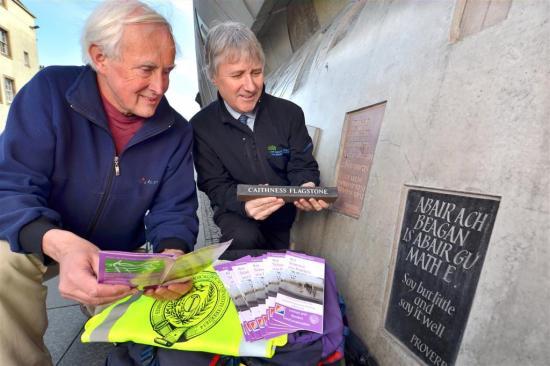Read It In The Stones
14th October 2011

Many acres of print have been written about the Scottish Parliament building but now a new publication will illuminate an unusual corner of this much talked about structure. A Scottish Natural Heritage funded leaflet will lift the lid on the stones in the Canongate Wall.
Under the fa�ade of the Canongate side of the parliament building is the Canongate Wall. During the construction of the parliament buildings a blast wall was incorporated into the design. The 39 metres long and 6 metres high wall, at its highest point, is set with a selection of Scottish rocks, some of which have Scottish texts carved onto the face. These texts were selected by a panel of MSPs, together with a literature expert, and include suggestions submitted by the Scottish people.
In all 24 pieces were chosen for the original design, ranging from Sir Walter Scott to Alasdair Gray. In 2010, to mark the tenth anniversary of the Scottish Parliament in 2009, two more stones were added. In total there are 28 panels of Scottish rocks; from red sandstone from Dumfriesshire, formed when Scotland was a desert, to volcanic grey granites from Aberdeenshire.
Mike Browne of Lothian and Borders GeoConservation Group, who co-ordinated the leaflet project said: "The rocks come from all over Scotland and include very ancient rocks, as well as geologically young ones. Also incorporated are 'Brewery Stones' recovered from the former brewery building which was demolished to make way for the new parliament. We hope the leaflet will help people understand a bit more about this important building and the geology of Scotland."
The new leaflet about the wall, published by Lothian and Borders GeoConservation in association with Scottish Natural Heritage, explains where the rocks are from and how, and when, they were formed. It also includes the quotes inscribed on the rocks, who wrote them and where they can be found in print.
Iain Rennick, SNH's area manager, said: "The wall is a fascinating mix of art, history and science. Scotland is the 'home of geology' and we have some of the oldest rocks in the world. The modern Scottish Parliament is one of the newer Scottish institutions, so it is fitting that the concrete blast wall is set with Scotland's ancient rocks - a marriage of old and new which this new leaflet reveals."
The overall design of the Canongate Wall was by Sora Smithson and the Scottish rocks were carved by Gillian Forbes and Martin Reilly. As well as the Scottish rocks and carved text, there is also a reminder of the design of the building. At the eastern end of the wall is a townscape, based around the sketch by parliament architect Enric Miralles, of Edinburgh's Old Town as viewed from a room at the Balmoral Hotel in Edinburgh.
Gordon Stewart, head of visitor services at the Scottish Parliament said: "Everyone interested in literature, geology, art - or just those wanting to know what the stones are and where the quotes are from - will hopefully find the leaflet interesting. I hope it will encourage people to come and have a look at this unusual bit of the building - and also come inside and see Scottish politics in action."
The free leaflet is available at the parliament and can also be downloaded at http://www.edinburghgeolsoc.org/r_download.html. It is one of a series of leaflets published by Lothian and Borders GeoConservation covering interesting aspects of local geology.
A detailed Pdf leaflet can be found at
http://www.edinburghgeolsoc.org/downloads/lbgcleaflet_canongatewall.pdf
Photo
L-R Mike Browne (Lothian & Borders Geoconservation Group) and Iain Rennick (Scottish Natural Heritage) examine a piece of Caithness flagstone and the panel set in the Canongate Wall which is made of it.
Edinburgh Geological society Web Site
http://www.edinburghgeolsoc.org/
SNH
Scottish Natural Heritage is the Government's adviser on all aspects of nature and landscape across Scotland. Our role is to help everyone understand, value and enjoy Scotland's nature now and in the future. For further information on SNH, please visit our website at www.snh.gov.uk
